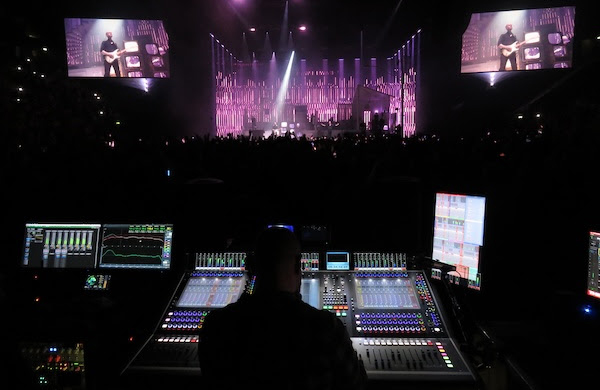English pop-rock band The 1975 has long toured with DiGiCo consoles, including an extensive set of dates in North America last fall that saw front of house engineer Lee McMahon utilizing a Quantum7 and monitor engineer Francois Pare working behind a Quantum5.
For Pare at the monitor position, it started at DiGiCo headquarters in Chessington in the mid 2000s on a training day with the manufacturer’s Tim Shaxson. “I don’t think I’ve used any other desk since 2016,” says Pare. “Nowadays the shows are so involved, there aren’t many desks that can handle the number of channels we need. On The 1975, we have an eight-piece band, and the show is quite theatrical, there’s a lot going on effects-wise onstage, so it all adds up!”
At front of house, McMahon’s story is similar, and he’s been using DiGiCo consoles exclusively since 2018: “Building this show has been an amazing journey; the band really care about sonics and how to interpret album production elements in the live domain. That’s something I take very seriously. I want to present their craft in the best way possible, sometimes pushing the boundaries of what is traditionally achievable within occasionally hostile acoustic spaces. It’s been a lot of fun bringing this show to fans all around the world. I’ve toured with SD11i, SD12, SD10 and SD5 consoles at different times over the years, but the Quantum processing has given me a lot more room to do things the way I want to.”
With a complex show, a lot of channels are needed, so it’s important to organize to help ensure easy access. “Broadly speaking, I mix inputs to Groups that combine at the Master bus,” McMahon explains. “I have around 200 channels, accounting for around 128 stage inputs, effects returns, utility channels and playback. I’m using matrices to drive PA, nearfields, auxiliary record feeds, two-tracks and VIP feeds. I use a lot of Groups, about 80 percent of my show is just on the Control Group layer which is controlling a mixture of input channels, group output and aux sends. This means I can keep my head up and respond to the mix as I want to, without having to hop around the console.”
The Quantum range has had from a series of upgrades, including the Mustard Processing and Spice Rack. Using the Naga 6 software engineers can solo filter bands without affecting the output of the channel, allowing them to monitor and audition dynamic filters during the show.
“I’ve got 152 input channels, around 59 Auxes and a 31 x 16 Matrix,” explains Pare. “It’s a huge show. I try to keep my use of the onboard features as limited as possible to keep the show streamlined, just in case, but the Mustard and Chilli are really needed. There is a distortion we use on the saxophone, of all things. It’s an octave down and adds a kind of guitar feel, thickening up the mix. It’s really nice and I’d need to have an outboard distortion if I didn’t have that. We also use it for vocals, so it’s handy to have. The EQs are really good, too.”
Communication across multiple departments is key when shows are this complex, but when setup time is tight, a fail-safe method for resetting the monitor desk into show mode is needed.
“The thing I use the most of are the Macros. I have 24 channels of talkback and you don’t want to accidentally leave talkback open during the show. We have different systems — Riedel, Motorola, etc. It’s a matrix of communication, so the Macros are really important — we turn around so quickly, it’s vital to have a speedy way of resetting. Knowing I’ve got those 40 or so buttons that can be anything I want just makes it so much faster. The competition doesn’t have that. It’s really flexible and it is what sold me on the DiGiCo from the get-go.”
“I use a lot of Macros at front of house, too,” adds McMahon. “Some are triggered by GPI pedals at my feet, others from custom-made buttons on the surface, as well as QLab chasing timecode and firing MIDI back into the console. It has given me the ability to do a lot of ‘momentary’ mix moves that are repeatable, in ‘time zero’ and seamless. The recall scope that DiGiCo consoles have is unparalleled in my opinion – you can literally do whatever you want and adapt to change quickly.”




















